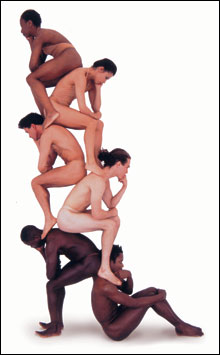Keep it movingThe ever-evolving Pilobolus September 25,
2007 2:10:15 PM

GROUP EFFORT The Pilobolus troupe think it
over.
|
When Dartmouth college students Robby Barnett, Michael Tracy, and Jonathan Wolken met in a dance class in the fall of 1970, they knew very little about dance. But now, 35 years after they founded a four-person dance company, they are still the artistic directors of the innovative, influential, and internationally-renowned Pilobolus. Returning to the FirstWorksProv Festival, Pilobolus will appear at the Providence Performing Arts Center on September 29 at 8 pm.
The Pilobolus troupe was named after a common barnyard fungus whose spores accelerate from 0-40 mph in the first millimeter of flight and, in similar fashion, the company took off with lightning speed. From their earliest exposure at the American Dance Festival to last spring’s appearance on the Academy Awards, Pilobolus has continued to wow new audiences and dance fans alike with their blend of acrobatic prowess, evocative body sculptures and dynamic phrasing.
Over the years, the original dancers have been replaced by a new generation of performers, but the founders are never far from shaping the dances and the company, as administrators, directors, and choreographers. Wolken, on
a recent very upbeat day, laughed at himself for being “still fool enough to be doing this.” In a phone conversation from his office at Pilobolus headquarters in northwestern Connecticut, he spoke about his role in the company and the pieces that Pilobolus will present in Rhode Island.
“I’ve been doing this 37 years, and I still love the adventure of it,” Wolken reflected. “What I do is balance the business endeavor with the artistic. Both are legitimate; both are fascinating. It’s still the big experiment: ‘What can we do with what we’ve got?’ ”
He also sees another kind of balance as essential to Pilobolus:
“If you look at the body of work, the pieces sway back and forth between abstract and theatrical, between kinetic and imagistic. These forces or tropes or poles are continually attracting and repelling us. The things I do now I won’t be really fascinated with two years from now. We think of the process as in flux, as always evolving.”
The program planned for Providence aptly demonstrates that: a classic solo from 1974 (Pseudopodia); an American Dance Festival piece commissioned for Pilobolus’s 20th anniversary in 1991 (Sweet Purgatory); and three recent works — Aquatica (2005), Prism (2006), and Persistence of Memory (2007). Pseudopodia is, in Wolken’s words, “all rolls and tumbles, no feet.” Sweet Purgatory is set to Shostakovich’s 8th Quartet, with its urgent and thrilling score. It represents a descent into Hades and a climb back up into Purgatory toward hope. “It’s one of our more serious works,” Wolken noted. “It’s reminiscent of the state of the world, not just then, in the ’90s, but now.”
Aquatica is a light story about a woman who plays in the sea and encounters those who live underwater, some recognizable as marine creatures and some quite fantastical. The full company of seven dancers takes part in this mysterious but humorous dance, replete with Pilobolus’ signature leaps and poses. Prism is a quartet that is part film noir, part psychological pondering, set to a pulsating score by Coldplay. Persistence of Memory is Michael Tracy’s wrenching duet in memoriam to the passing of a close friend’s family member.
Though Pilobolus pieces are created collaboratively, with input from dancers as well as choreographers, it’s common for one person to take the lead, as Tracy did in Persistence. Wolken was particularly cheerful when we spoke because he was at a crucial point in choreographing a new work.
“When it begins to come together as it is right now,” he enthused, “and you feel something click, it’s tremendously gratifying. Before that, you feel that your whole self is on the line.”
In recent years, he’s felt a new appreciation, a new understanding, from Pilobolus’s audiences. “Dance is a very hand-made art form,” he emphasized. “By contrast to the rest of the virtual, digital world, coming to a theater and giving yourself to the performance and seeing people do what we do is a tremendous human thing. Most people see very different things in our pieces, and at no time would we hope that there’s a narrow interpretation of our work.”
|
 |

|
- Our critics pick the 14 producers with the fattest, meanest beats
- Ben is back with Gone Baby Gone
- Never mind its tough-girl alt-porn feminism: SuicideGirls has already moved on to a new generation
- Comic timing
- Steve Albini speaks
- In his bid for re-election, city councilor Stephen Murphy has collected a combustible group of allies, from Dapper to Deval
- Evangelicals are speaking in bubbles — and fighting God’s war on pop culture
- Kerry Stuart Coppin’s images of Africa and beyond
- Lessons from the build-them-up, tear-them-down Boston firefighter backlash
- Kick him when he's down
- Freedom watch
- Music seen at the Cumberland County Civic Center, October 4, 2007
|
-
An unusually good Italian
-
Festival Ballet’s fresh take on Cinderella
-
Peruko Ccopacatty’s fresh perspective
-
A neighborhood champion
-
A full slate of classics, new works, and seasonal treats
-
Royal feasts and more
-
Island Moving Co.’s Newport Stories
-
Nalini Jones’s universal portraits
-
Judith Black’s tales take you on a journey
|

- Boston Ballet in Serenade and La Sylphide
- Boston Ballet’s ‘Night of Stars’
- Bunraku at the Majestic; Marcus Schulkind at Green Street
- Island Moving Co.’s Newport Stories
- And Hubbard Street Dance deliver
- Invisible Wings, plus Henri Oguike and Bridgman/Packer at Jacob’s Pillow
- Portland Dances! addresses society's problems
- Boston Ballet on tour
- Fist and Heel at Concord’s Summer Stages and Kabuki in New York
|
|